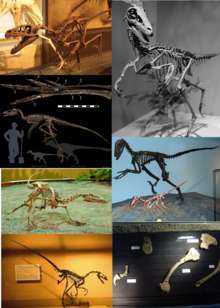| Deinonychosaurs Temporal range: Middle Jurassic–Late Cretaceous,
| |
|---|---|

| |
| Montage of putative deinonychosaurians | |
| Scientific classification | |
| Domain: | Eukaryota |
| Kingdom: | Animalia |
| Phylum: | Chordata |
| Clade: | Dinosauria |
| Clade: | Saurischia |
| Clade: | Theropoda |
| Clade: | Pennaraptora |
| Clade: | Paraves |
| Clade: | †Deinonychosauria Colbert & Russell, 1969 |
| Subclades | |
| |
Deinonychosauria is a clade of paravian dinosaurs which lived from the Late Jurassic to the Late Cretaceous periods. Fossils have been found across the globe in North America, Europe, Africa, Asia, South America, and Antarctica,[2] with fossilized teeth giving credence to the possibility that they inhabited Australia as well.[3] This group of dinosaurs are known for their sickle-shaped toe claws and features in the shoulder bones.[4]
Deinonychosauria is commonly defined as all dinosaurs more closely related to dromaeosaurids (such as Deinonychus antirrhopus) than to birds (such as Passer domesticus). It traditionally includes the families Dromaeosauridae and Troodontidae, which each possess enlarged "sickle claws".[5] However, troodontids may instead be closer to birds than to dromaeosaurids, so they would lie outside Deinonychosauria under that hypothesis. This would also render Deinonychosauria equivalent to Dromaeosauridae, under a broad definition of the family.[6] As the structure of the paravian family is still undergoing debate, the components of Deinonychosauria is unstable beyond dromaeosaurids.[1]
- ^ a b Hartman, Scott; Mortimer, Mickey; Wahl, William R.; Lomax, Dean R.; Lippincott, Jessica; Lovelace, David M. (2019). "A new paravian dinosaur from the Late Jurassic of North America supports a late acquisition of avian flight". PeerJ. 7: e7247. doi:10.7717/peerj.7247. PMC 6626525. PMID 31333906.
- ^ Case, J.A., Martin, J.E., and Reguero, M. (2007). "A dromaeosaur from the Maastrichtian of James Ross Island and the Late Cretaceous Antarctic dinosaur fauna." Pp. 1–4 in Cooper, A., Raymond, C., and Team, I.E. (eds.), Antarctica: a Keystone in a Changing World – Online Proceedings for the Tenth International Symposium on Antarctic Earth Sciences, U.S. Geological Survey Open-File Report 2007-1047, SRP 083. U.S. Geological Survey, Washington, D.C.
- ^ "Oz dromaeosaurs(Re: Megaraptor)".
- ^ Cite error: The named reference
ostrom1974was invoked but never defined (see the help page). - ^ Cite error: The named reference
turneretal2012was invoked but never defined (see the help page). - ^ Cite error: The named reference
AurornisNaturewas invoked but never defined (see the help page).